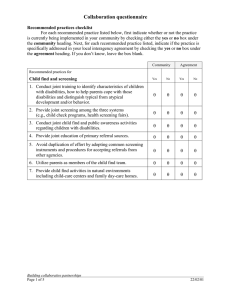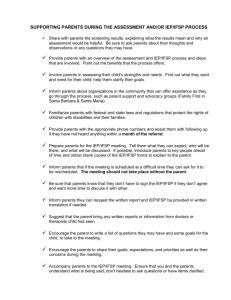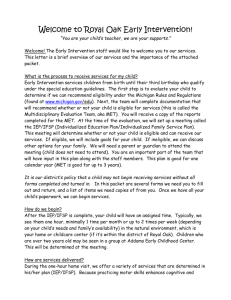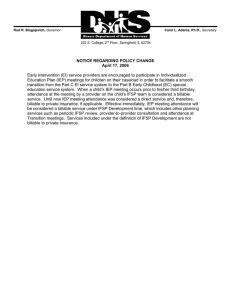Collaboration questionnaire (long)
advertisement
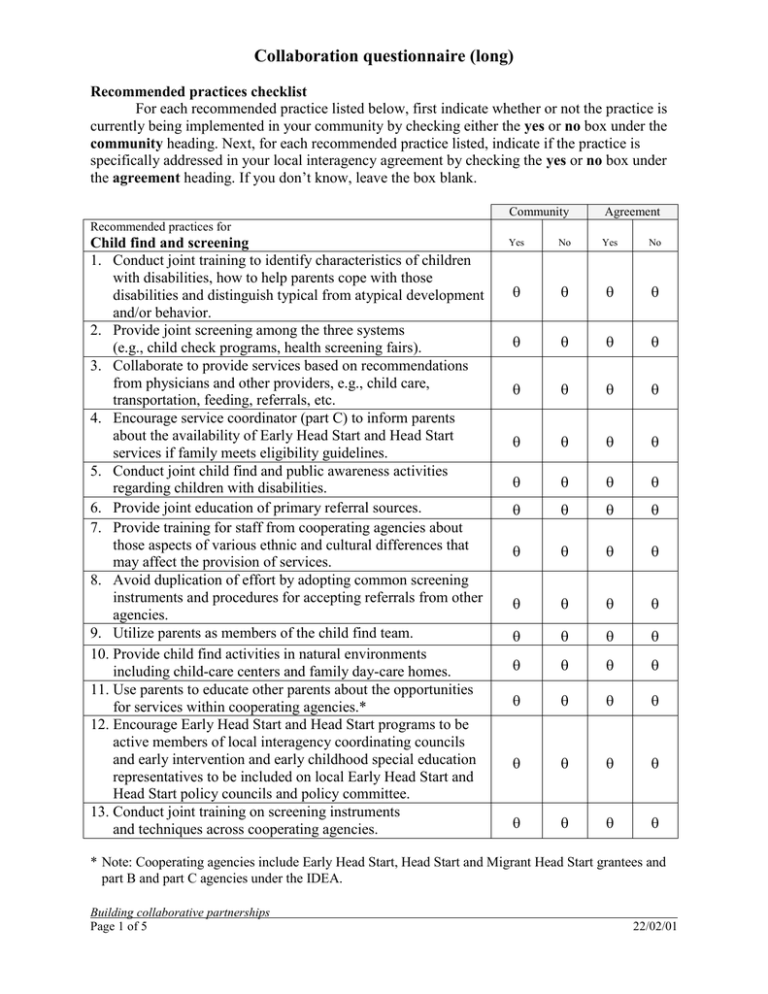
Collaboration questionnaire (long) Recommended practices checklist For each recommended practice listed below, first indicate whether or not the practice is currently being implemented in your community by checking either the yes or no box under the community heading. Next, for each recommended practice listed, indicate if the practice is specifically addressed in your local interagency agreement by checking the yes or no box under the agreement heading. If you don’t know, leave the box blank. Community Agreement Yes No Yes No Recommended practices for Child find and screening 1. Conduct joint training to identify characteristics of children with disabilities, how to help parents cope with those disabilities and distinguish typical from atypical development and/or behavior. 2. Provide joint screening among the three systems (e.g., child check programs, health screening fairs). 3. Collaborate to provide services based on recommendations from physicians and other providers, e.g., child care, transportation, feeding, referrals, etc. 4. Encourage service coordinator (part C) to inform parents about the availability of Early Head Start and Head Start services if family meets eligibility guidelines. 5. Conduct joint child find and public awareness activities regarding children with disabilities. 6. Provide joint education of primary referral sources. 7. Provide training for staff from cooperating agencies about those aspects of various ethnic and cultural differences that may affect the provision of services. 8. Avoid duplication of effort by adopting common screening instruments and procedures for accepting referrals from other agencies. 9. Utilize parents as members of the child find team. 10. Provide child find activities in natural environments including child-care centers and family day-care homes. 11. Use parents to educate other parents about the opportunities for services within cooperating agencies.* 12. Encourage Early Head Start and Head Start programs to be active members of local interagency coordinating councils and early intervention and early childhood special education representatives to be included on local Early Head Start and Head Start policy councils and policy committee. 13. Conduct joint training on screening instruments and techniques across cooperating agencies. * Note: Cooperating agencies include Early Head Start, Head Start and Migrant Head Start grantees and part B and part C agencies under the IDEA. Building collaborative partnerships Page 1 of 5 22/02/01 Collaboration questionnaire (long) Community Agreement Yes No Yes No Recommended practices for Child evaluation 1. Develop and use interagency multidisciplinary teams to evaluate children in their natural setting. 2. Use language and terms that are understandable to parents. 3. Avoid duplication by using evaluation data from other agencies if done by personnel who meet the credentialing requirements as identified in the regulations of the agency responsible for determining eligibility. 4. Encourage the use of the Consent to Exchange Information form by all three parties to this agreement.* 5. Share information regarding evaluation results among agencies with appropriate parent consent. 6. Provide parents with the opportunity to identify other services, resources and programs in which their children are participating in order to provide a complete picture of the children’s skills and needs. 7. Conduct joint training on timelines, evaluation instruments and techniques across cooperating agencies. 8. Assure joint participation of parents and staff of cooperating agencies in the multidisciplinary evaluation team. 9. Provide parents with information regarding Virginia’s parental choice policy for services for two-year-old children with disabilities. 10. Collaborate among agencies to coordinate logistics necessary for evaluation. * Note: Early Head Start and Head Start agencies can be added to the Consent to Exchange Information form, developed by state agencies and approved by the Office of the Attorney General, by using the space for “other agencies.” Community Agreement Yes No Yes No Recommended practices for Determination of eligibility for services 1. Share among local agencies eligibility criteria, regulations and other information that affect where and how children receive services. These might include program curriculum, class size, space constraints, safety issues, transportation, accessibility, etc. 2. Assure joint participation of parents and staff of cooperating agencies (e.g., Early Head Start and Head Start staff would serve on child study and the eligibility teams with parents and part C or part B staff). Building collaborative partnerships Page 2 of 5 22/02/01 Collaboration questionnaire (long) Community Agreement Yes No Yes No Recommended practices for Individualized Family Service Plan development*/ Individualized Education Program*/placement 1. Encourage early intervention and school divisions to invite the Early Head Start/Head Start staff to participate in the development of the IFSP/IEP. If the child is already enrolled in Early Head Start or Head Start, the Head Start teacher or the staff person who is most aware of the child’s development should participate. If Early Head Start/Head Start is being considered as a location/placement option, then the staff member who is responsible for the Early Head Start/Head Start disabilities services should participate. 2. Consider alternate methods of participation for IFSPs and IEPs such as telephone, facsimile and e-mail communication. 3. Encourage parents to consider the inclusion of staff members from all programs serving their children in the IFSP/IEP development process. 4. Provide opportunities for Early Head Start and Head Start personnel serving part C-eligible infants and toddlers who are enrolled in their program to participate in the IFSP development process. 5. Encourage the IFSP/IEP team to consider the use of an Early Head Start or Head Start program as one of the options to meet child outcomes. 6. Refer any Early Head Start- and Head Start-enrolled child who has moved into a new service area from another jurisdiction to the early intervention provider or local school division and advise the provider that a current IEP or IFSP may exist. 7. Assist parents to compile and maintain complete and accurate records regarding their children. These might include results of screenings, evaluations, IFSPs, IEPs, etc. 8. Provide joint training to staff from cooperating agencies on the IFSP/IEP process to promote active, informed participation in the IFSP/IEP meetings. 9. Provide training to parents on the IFSP/IEP process to promote active, informed participation in the IFSP/IEP process. * Note: IEPs are developed as part of the part B of IDEA. IFSPs are developed as part of the part C of IDEA. Building collaborative partnerships Page 3 of 5 22/02/01 Collaboration questionnaire (long) Community Agreement Yes No Yes No Recommended practices for Placement and provision of services 1. Allow children who meet the eligibility for Early Head Start and Head Start and either part B or C to be enrolled in both programs. 2. Use the expertise of Early Head Start and Head Start, LEA and early intervention staff to achieve individual goals for children who are eligible for dual enrollment. 3. Individualize the amount of time spent in either Early Head Start and Head Start and part B or C programs according to the needs of the child. 4. Create opportunities for staff of both Early Head Start and Head Start and either part B or C programs to observe each other’s work with children and maintain communication about those who are dually enrolled. 5. Provide therapies and related services as identified in the IEP to be delivered whenever appropriate in the inclusive setting where the child is served. 6. Provide early intervention direct services identified in the IFSP to be delivered in natural environments whenever appropriate. 7. Provide opportunities and encourage parents to actively participate in their child’s program and instruction. Community Agreement Yes No Yes No Recommended practices for Transition 1. Provide training for staff from part C, part B, Early Head Start and Head Start programs in transition planning, implementation and evaluation of the transition process. 2. Develop joint transition plans among Early Head Start, Head Start, part C and part B programs, and from Head Start and part B to school-age programs. 3. Inform parents of the differences among systems in role, staffing patterns, costs or fees, schedules and services. 4. Share staff members across systems in order to facilitate a smooth transition. 5. Provide early and mutually planned transfer of records with parent consent at times convenient for both systems. Building collaborative partnerships Page 4 of 5 22/02/01 Collaboration questionnaire (long) Community Agreement Yes No Yes No Recommended practices for Funding 1. Be aware of available state and federal resources for children from birth through age five, the procedures for acquiring funding and the procedures for counting children for funding as required by each agency. 2. Allocate sufficient resources to meet training needs of parents and staff. 3. Identify those services that are to be provided at no cost and those for which fees will be charged. 4. Ensure that parents understand their financial responsibility, if any, for services provided to their children. 5. Share personnel/services with or without an exchange of funds, depending upon the needs and resources of each provider. 6. Use the local interagency coordinating councils to collaborate on issues related to funding. 7. Identify and cultivate creative funding sources through grant writing and other endeavors to enhance services for young children in the community and to provide adequate child-care and recreational options for children with disabilities and their families. 8. Explore and use innovative methods for financing the costs of services, including dual enrollment, itinerant teacher arrangements and other cost-effective, coordinated service delivery arrangements. 9. Develop rationale and recommendations needed to secure additional state funding to meet service delivery needs. Building collaborative partnerships Page 5 of 5 22/02/01
